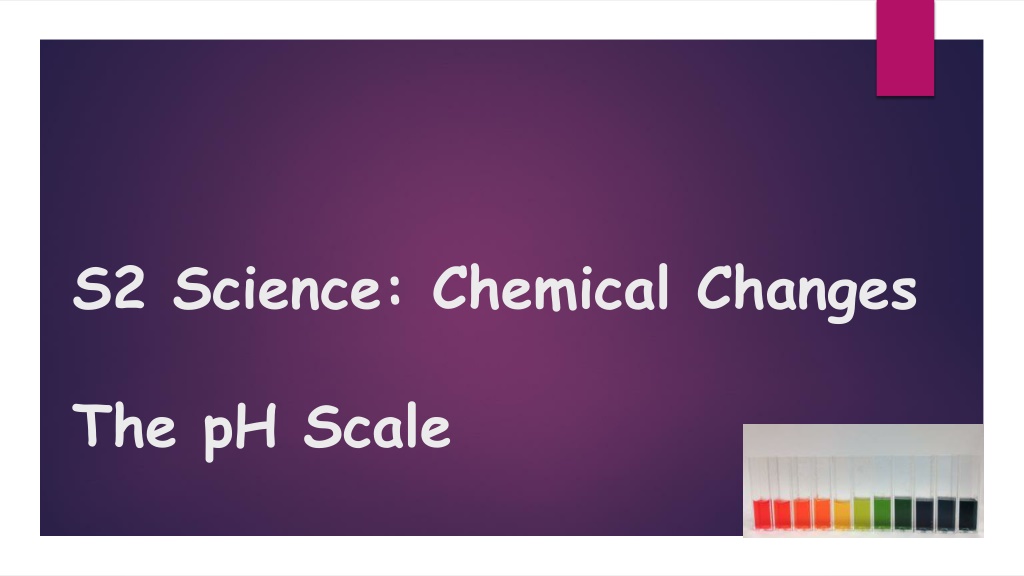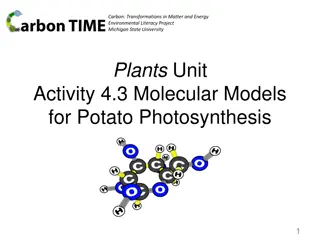S2 Science: Chemical Changes The pH Scale
Delve into the fascinating world of acids and bases with practical activities on the pH scale. Discover the properties of different substances, learn to measure and adjust pH levels, and explore the significance of pH in everyday life. From indicators to universal indicator colors, this educational journey covers it all.
Download Presentation

Please find below an Image/Link to download the presentation.
The content on the website is provided AS IS for your information and personal use only. It may not be sold, licensed, or shared on other websites without obtaining consent from the author. Download presentation by click this link. If you encounter any issues during the download, it is possible that the publisher has removed the file from their server.
E N D
Presentation Transcript
S2 Science: Chemical Changes The pH Scale
The pH Scale: Benchmarks Science Benchmark Having taken part in practical activities to compare the properties of acids and bases, I have demonstrated ways of measuring and adjusting pH and can describe the significance of pH in everyday life. SCN 3-18a Literacy Benchmarks I can make notes and organise them to develop my thinking, help retain and recall information, explore issues and create new texts, using my own words as appropriate. LIT 3-15a / LIT 4-15a I can convey information, describe events, explain processes or concepts, and combine ideas in different ways. LIT 3-28a Numeracy Benchmark I can display data in a clear way using a suitable scale, by choosing appropriately from an extended range of tables, charts, diagrams and graphs, making effective use of technology. MTH 2-21a / MTH 3-21a
Powerpoint Icons All the Powerpoints used in the course have the same icons so you know what to expect. The icons used are: A note to copy Numeracy Health and Wellbeing Question/Think point Citizenship Literacy Videoclip
Lesson 1: Indicators and the pH Scale Success Criteria describe the colour changes of universal indicator when added to acids and bases identify substances as acidic (pH of less than 7), alkaline/basic (pH of greater than 7) or neutral (pH equal to 7)
Indicators and the pH Scale Acids and bases (alkalis) can be found all around us, in our school lab and in our homes. Can you name any acids or alkalis? Laboratory Acids Household Acids hydrochloric acid vinegar sulfuric acid lemon juice nitric acid cola
Laboratory alkalis Household alkalis sodium hydroxide baking soda potassium hydroxide bleach limewater indigestion remedies
Universal Indicator Indicators, such as universal indicator, are chemicals which produce different colours when placed in acids and alkalis/bases. Universal indicator is a mixture of different indicator chemicals. Universal indicator colours can be matched to a number on the pH scale. As it can change through a range of different colours, it can also be used to show the strength of an acid or alkali.
The pH Scale The pH scale is used to determine how acidic or alkaline a substance is. The range of the pH scale is from below 0 to above 14 but between 0-14 is where the pH of most substances occur. acids getting stronger alkalis getting stronger
Collect a copy of a pH scale diagram and stick it into your jotter. Copy and complete the note below under the diagram. Acids have a pH of ______ than 7. Alkalis/bases have a pH of _____ than 7 and neutral substances have a pH ________ to 7.
Everyday Substances Predicting pH ACTIVITY 1 In pairs, collect a copy of a pH scale and cut-outs of everyday substances. Place each substance at the correct number on the pH scale. This might take several attempts as, at this stage, you are likely to be guessing (creating a hypothesis). You will confirm this by experiment in the next lesson. Check with your teacher how many you have correct.
Lesson 2: Testing Everyday Substances Success Criteria investigate and describe the pH of everyday substances. write a report on the experiment.
Experiment 1: Testing Everyday Substances Aim: To find the pH values of everyday substances and to classify them as acidic, alkaline or neutral. Procedure: Follow the instructions as detailed on the experiment card.
Raw Data (Results): Substance Colour of Indicator pH Acidic/Alkaline/Neutral Processed Data: Complete the last column in the table to classify each substance as acidic, alkaline or neutral.
Experiment Report Write a brief report on the experiment using the following headings Title: Testing Everyday Substances Aim: To use universal indicator to test the pH of everyday substances. Summary of Procedure: A brief sentence or diagram to describe how you carried out the experiment. Raw Data: Your results table. Processed data: Final Column of your Table Conclusion: Identify substances as acids or bases
Lesson 3: Natural Indicators Success Criteria prepare red cabbage indicator and use it to describe the pH of everyday substances write a report on the experiment.
Natural Indicators Nature has given us many plants that can be used to test the pH of solutions. These include beetroot, blackberries, blueberries, geranium petals, onion, turmeric, rose petals, tea and red cabbage among a variety of others. Hydrangea Flower Colours in Different Soil pH
Red cabbage juice contains a natural pH indicator that changes colour depending on the acidity of the substance it is added to. Red Cabbage Indicator Colour red purple violet blue blue-green green-yellow pH 2 4 6 8 10 12
Experiment 2: Red Cabbage Indicator Aim: To make an indicator from red cabbage and use it to determine the pH of everyday substances. Procedure: Follow the instructions as detailed on the experiment card. Raw and Processed Data:
Experiment Report Write a brief report on the experiment using the following headings Title: Aim: Summary of Procedure: Raw Data: Processed data: Conclusion:
DYW Spotlight on a Career Textile Dyeing Technician Mixing chemicals from plants to create dyes for fabrics and textiles. Researching to create the right colour, temperature and dyeing method. Salary from 22,000 to 68,500 per year. Working 37 40 hours per week (possibly on a shift system). Entry Requirements: Degree/HNC/HND in subjects like chemistry, chemical engineering, colour science, physics OR a Modern Apprenticeship in Textile Manufacture Skills required taking initiative, planning and development, analysing observation, working with numbers, problem solving
Lesson 4: Investigating Indicators Success Criteria investigate and describe the colour changes of different indicators when added to acids and bases
Investigating Indicators pH Indicators are substances that change colour when they are added to acidic or alkaline solutions. Universal indicator is commonly used but there are a number of other pH indicators including methyl orange, phenolphthalein and bromothymol blue. Experiment 3: Investigating Indicators Aim: To compare the colour changes of different indicators with acids and alkalis. Procedure: Follow the instructions as detailed on the experiment card. Raw Data: Collect a copy of the results card and use coloured pencils to fill in the colours. Glue this into your jotter.
Lessons 5 & 6: Neutralisation Success Criteria investigate and describe what happens to the pH when an acid is added to an alkali/base. complete word equations to name the salts formed in an acid/alkali neutralisation reaction.
Acid-Base Reactions A neutralisation reaction occurs when an acid reacts with a base (alkali). During the neutralisation reaction, the pH of solution will move towards pH 7 (neutral). Experiment 4: Acid/Alkali Neutralisation Aim: To investigate what happen to the pH when an alkali is added to an acid. Procedure: Follow the instructions as detailed on the experiment card. Raw Data: Record your results in an appropriate format.
Conclusion (Copy and complete) When an alkali is added to an acid, the pH of the acid ___________ towards pH 7. The pH of the alkali ___________ towards pH 7. When an acid and alkali react together in a neutralisation reaction, they form a SALT and WATER. General Word Equation acid + alkali REACTANTS salt + water PRODUCTS Word Equation hydrochloric acid + sodium hydroxide sodium chloride + water The type of salt formed depends on the acid and alkali used in the reaction
Naming Salts The salt formed depends on which acid and alkali have been used in the neutralisation reaction. The first part of the salt name comes from the first (metal) part of the alkali The second part of the salt name comes from the acid as shown below: Name of Acid hydrochloric acid nitric acid sulfuric acid ethanoic 2ndpart of the Salt Name chloride nitrate sulfate ethanoate
Activity Complete the following word equations as shown in the example below; hydrochloric acid + sodium hydroxide sodium chloride + water 1.nitric acid + potassium hydroxide 2.sulfuric acid + calcium hydroxide 3.hydrochloric acid + lithium hydroxide
Activity Answers Complete the following word equations as shown in the example below; hydrochloric acid + sodium hydroxide sodium chloride + water 1.nitric acid + potassium hydroxide potassium nitrate + water 2.sulfuric acid + calcium hydroxide calcium sulfate + water 3.hydrochloric acid + lithium hydroxide lithium chloride + water
Lessons 7: pH in Everyday Life research information on the significance of pH in everyday life. produce a presentation to display the information.
Lessons 7: pH in Everyday Life RESEARCH Choose ONE of the following topics to research the effect of acids on human health OR the effect of acids on the environment PRESENTATION Present the information in one of the following ways PowerPoint Presentation Poster Leaflet Video Clip Podcast























